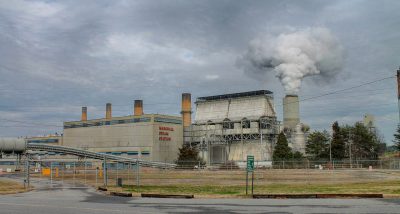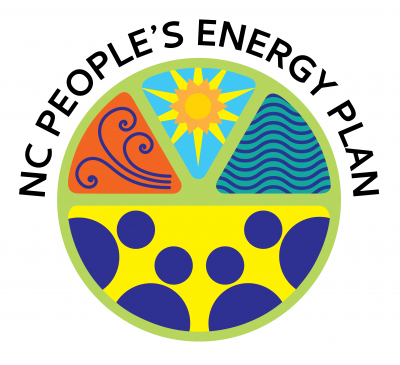Front Porch Blog

Graphic created by Appalachian Voices staff
For decades, energy prices have been at the mercy of markets and regulators that saw fossil fuels as the best way to ensure access to reliable and “least-cost” energy, despite wild fluctuations in prices, while renewable energy was held back because of efforts by politicians, large utilities and lobbyists to stall sufficient investment in the technology. The lack of investment kept the price of these renewable energy technologies high, and out of reach for many Americans.
This is no longer the case. We have the tools to reduce carbon emissions and other pollutants and improve public health, all while reducing our energy costs. So why is my energy bill expected to go up roughly $25 over the next three years?

Duke Energy’s Marshall Steam Station. Photo by Cdtew at English Wikipedia
In October, Duke Energy Progress asked the commission to review a three-year rate increase expected to raise the average monthly bill from $126.43 to $141.15 in late 2023 and up to $151.98 by 2025. Duke Energy Progress promises customers that these rate hikes are necessary to modernize the grid and make infrastructure improvements ensuring the “grid [is] more resistant to severe weather” while supporting “economic development and new jobs.”
I want to be very clear, I’m not trying to negate the importance of these investments. On the contrary, updating the grid is essential. Preparing for severe weather events from climate change is a must. Economic development and new jobs for communities experiencing coal plant closures is, if anything, an under-discussed aspect of these conversations.
But, why are we paying for it?
Let’s put these rate increases into context. We are shifting towards more renewable energy being on the grid, and for decades we’ve heard this transition will raise energy prices. Climate change is here and extreme weather events are not only costly but also increase the need for grid updates to maintain reliability. Duke is required to reduce carbon emission by 70% from 2005 levels by 2030 and still anticipates growth in electricity demand. These things alone could cost money. However, we now have unprecedented federal investment opportunities to prevent our utility bill from going up and I want North Carolina utilities to take advantage of these opportunities.
The Inflation Reduction Act and parts of the Infrastructure Investment and Jobs Act, a.k.a. the bipartisan infrastructure law, are changing the game, and Duke Energy needs to get on board.
Together, these bills offer options for utilities, including federally subsidized loan programs for operation and transmission upgrades, investment in smart grids and even funding for workforce development. These programs add more renewable energy to the grid, reducing energy costs while increasing reliability. While some of these programs won’t open till 2023, utility companies can be preparing now to utilize these funds and pass savings onto customers instead of projecting three-year electricity bill hikes.
I’m not alone in thinking this. The Rocky Mountain Institute, a leading energy think tank, predicts that the IRA should save customers a total of $5 billion in electricity costs by the end of 2024. The residential customer savings from the IRA is something that Duke is taking advantage of, just not in North Carolina. They are expected to pass $56 million in savings to their Florida customers from solar tax credits from the IRA while actively underutilizing solar development in the Tar Heel State.
Duke Energy also sells the electricity they generate to municipally owned utilities and member-owned cooperative utilities, meaning there are few residents in North Carolina not impacted by Duke Energy’s decisions.
My dismay at Duke’s rate increases has been echoed by participants in our People’s Energy Plan survey and listening sessions where affordability is a notable issue. Many customers highlighted affordability as a key issue, including the need for the utility to prevent customers who are unable to meet their monthly bills from being disconnected.
In North Carolina, Duke Energy did propose a Customer Assistance Program as part of their proposed rate change to help households that can’t afford their electricity bills. The program would automatically enroll Low Income Energy Assistance Plan and Crisis Intervention Program recipients in a program providing a bill reduction of $42 per month.
The cost of the program would be paid for by other residential and commercial customers, which is justified by the fact that Duke Energy’s own analysis shows that low-income customers have been paying more than their fair share of Duke’s costs. Additionally, Duke Energy has proposed a tariffed on-bill financing program, which lets qualifying customers pay for energy efficiency upgrades on their monthly utility bills.
Because those upgrades lower customers’ bills, this can make energy efficiency improvement much more affordable. This program, if properly managed, could lower the amount of energy low-income residential consumers use, both shrinking the amount of emissions harming our planet, but also lowering their bills. Both programs are currently before the North Carolina Utilities Commission.
Next steps
Duke Energy Progress’ proposed rate increase will be under review at the utilities commission until mid-2023, and we all can continue to stay engaged. Rate cases have public comment periods where customers can make their voices heard, and Appalachian Voices will continue to share this information and follow these cases in the new year.

I’ll end by sharing one more of our People’s Energy Plan participants’ comments: Individuals and communities are our most “untapped resources” and if we “could mobilize the community to understand these issues [we] could make a lot of the changes.” To fully understand what these changes should look like, we need to keep learning from people across our state to better advocate for an energy system that works for everyone.
PREVIOUS
NEXT

Leave a comment
Your email address will not be published. Required fields are marked *

Leave a Comment